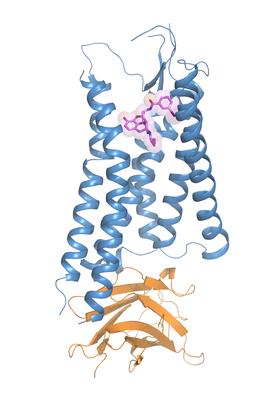In a paper published in Cell, research led by Bryan Roth, MD, PhD, and Roth lab members, Tao Che, PhD and Daniel Wacker, PhD, show how to activate only one kind of brain receptor vital for pain relief. This receptor is not involved in addiction or respiratory depression that leads to death – the most severe side effects of opioid use.

CHAPEL HILL, NC – For the first time, scientists at the University of North Carolina School of Medicine and collaborators solved the crystal structure of the activated kappa opioid receptor bound to a morphine derivative. They then created a new drug-like compound that activates only that receptor, a key step in the development of better pain medications.
The research, published in the journal Cell, shows a route toward creating opioids that relieve pain without causing the severe side effects at the heart of the opioid epidemic.
Currently, most opioids bind to several opioid receptors on the surface of cells, and this is one of the main reasons why opioids relieve severe pain but also trigger a wide range of side effects from nausea, numbness, and constipation to anxiety, severe dependency, hallucinations, and even death caused by respiratory depression.
“To create better opioids, we need to know the structure of their receptors,” said senior author Bryan Roth, MD, PhD, the Michael Hooker Distinguished Professor of Protein Therapeutics and Translational Proteomics in the Department of Pharmacology at UNC-Chapel Hill. “Until recently, this was impossible. But now we know the structure of the activated kappa opioid receptor. And we showed we can actually use the structure to make a drug-like compound with better properties than current opioids.”

The work was done in cell cultures in Roth’s lab, and in the future researchers will test this and related compounds in animal models. Also, using the detailed structure of the kappa opioid receptor (KOR), Roth’s lab and other scientists could develop other drug-like compounds highly selective for specific opioid receptors now that the structure is available.
“Tens of thousands people who take opioids die every year, and so we need safer and more effective drugs for treating pain and related conditions,” Roth said. “One of the big ideas is to target KORs because the few drugs that bind to it don’t lead to addiction or cause death due to overdose. Those side effects are mainly related to actions at the mu opioid receptor.”
Drugs that do hit KORs can have other side effects, such as hallucinations and dysphoria – a general state of unease or dissatisfaction with life related to anxiety and depression. This is why scientists need to know how this receptor is activated – to figure out the best way to bind a compound to KORs to only relieve pain.

Two postdoctoral fellows in Roth’s lab led the work – first author Tao Che, PhD, and corresponding author Daniel Wacker, PhD, who collaborated with several other scientists at UNC and around the world.
read the Cell journal article here…
watch WRAL News Video Highlighting drug-like compound that could treat pain without addiction…
